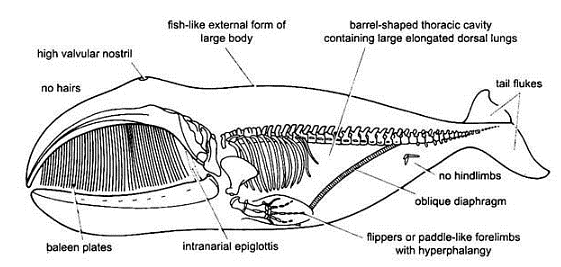UPSC Exam > UPSC Notes > Zoology Optional Notes for UPSC > Mammalia: Aquatic Mammals
Mammalia: Aquatic Mammals | Zoology Optional Notes for UPSC PDF Download
Introduction to Aquatic Mammals
Mammals, predominantly terrestrial, exhibit adaptations for life on land. Some mammals have successfully transitioned to aquatic habitats, evolving from their terrestrial ancestors.
Terrestrial Lung-Breathing Forms
Original Terrestrial Mode:
- Aquatic mammals, despite their aquatic lifestyle, breathe air through lungs.
- This suggests their evolutionary origin as terrestrial lung-breathing forms.
Reversion to Aquatic Life:
- Aquatic mammals, notably whales, have transitioned to water, possibly due to intense competition for food and shelter on land.
- This reversion to aquatic life has been remarkably successful.
Categories of Aquatic Mammals
1. Amphibious Mammals
- Definition: Mammals not permanently residing in water but using it for food and shelter.
- Adaptations:
- Small external ears.
- Webbed feet.
- Flattened nails.
- Subcutaneous fat.
- Examples: Beaver, musk rat, nutria, otter, mink, etc.
- Orders: Carnivora, Rodentia, Artiodactyla, Marsupialia, Monotremata, etc.
2. Aquatic Mammals
- Definition: Spend most of their time in water but come to land for reproduction.
- Examples: Seals, hippopotamus.
3. Marine Mammals
- Definition: Never come to land; fully adapted to life in water.
- Examples: Whales.
Adaptations of Aquatic Mammals
1. Modifications of Original Structures
- Body Shape:
- Fish-like form, elongated head, and streamlined body reduce resistance and enhance swimming.
- Large Size and Weight:
- Large size reduces skin friction, aids heat retention, and provides buoyancy in water.
- Flippers:
- Forelimbs transformed into skin-covered, un-jointed paddles for swimming stability.
- Hyperdactyly and Hyperphalangy:
- Extra digits and phalanges increase flipper surface area for efficient swimming.
- Nostril Placement:
- Nostrils far back on the head allow breathing without raising it much out of water.
- Mammary Ducts:
- Mammary ducts dilate to form milk reservoirs, facilitating underwater suckling.
- Oblique Diaphragm:
- Oblique diaphragm enlarges thoracic cavity for better lung expansion.
- Large Lungs:
- Large, unlobulated lungs aid in maximum air intake during submersion.
- Intra-Narial Epiglottis:
- Tubular intra-narial epiglottis allows simultaneous breathing and feeding underwater.
- Endoskeleton Modifications:
Cranium becomes small and wider; cervical vertebrae fuse; ribs arch dorsally.
Teeth in Toothed Whales:
Monophyodont, homodont teeth assist in capturing and swallowing prey without mastication.

- Loss of Hairs: Smooth, glistening skin due to the absence of hairs, except for sensory bristles.
- Absence of Pinnae: Pinnae absent to maintain streamlined body shape during swimming.
- Loss of Various Glands:Nictitating membranes, eye cleansing glands, lacrimal glands, and skin glands are absent.
- Reduced Hindlimbs and Pelvis:Hindlimbs represented by knobs in the fetus; pelvis rudimentary or absent in adults.
- Tail Flukes: Lateral expansions on the tail called tail flukes for propelling through water.
- Dorsal Fin: Unpaired adipose dorsal fin serves as a rudder or keel during swimming.
- Blubber: Thick subcutaneous layer of fat (blubber) for insulation, buoyancy, and emergency food reservoir.
- Baleen in Whalebone Whales: Absence of teeth replaced by baleen plates for filtering plankton.
- Foam: Emulsion of fat, mucus, and gas in middle ear cavities for sound insulation and improved hearing.
- Melon: Fatty mass in front of nostrils to detect pressure changes in water.
- Harderian Glands: Secretion protects eyes underwater.
- Aquatic mammals showcase a variety of adaptations, including modifications of original structures, loss of certain features, and the development of new structures.
- These adaptations demonstrate the remarkable evolutionary transitions that have enabled mammals to thrive in aquatic environments.
The document Mammalia: Aquatic Mammals | Zoology Optional Notes for UPSC is a part of the UPSC Course Zoology Optional Notes for UPSC.
All you need of UPSC at this link: UPSC
|
181 videos|346 docs
|

|
Explore Courses for UPSC exam
|

|
Signup for Free!
Signup to see your scores go up within 7 days! Learn & Practice with 1000+ FREE Notes, Videos & Tests.
Related Searches


















